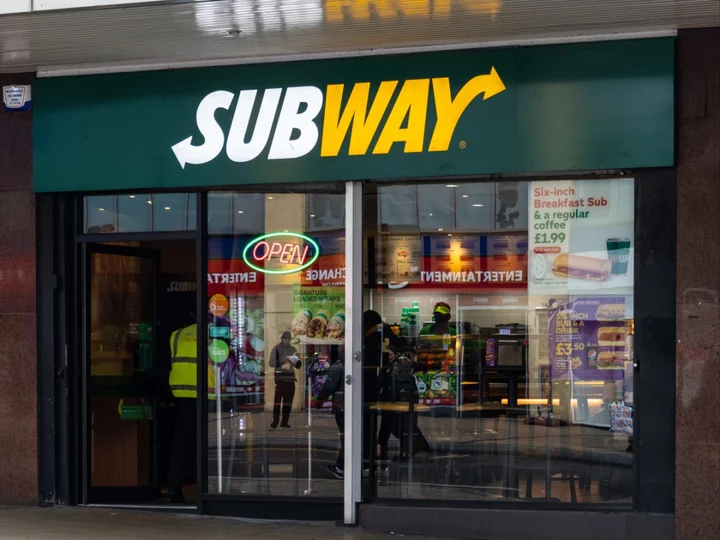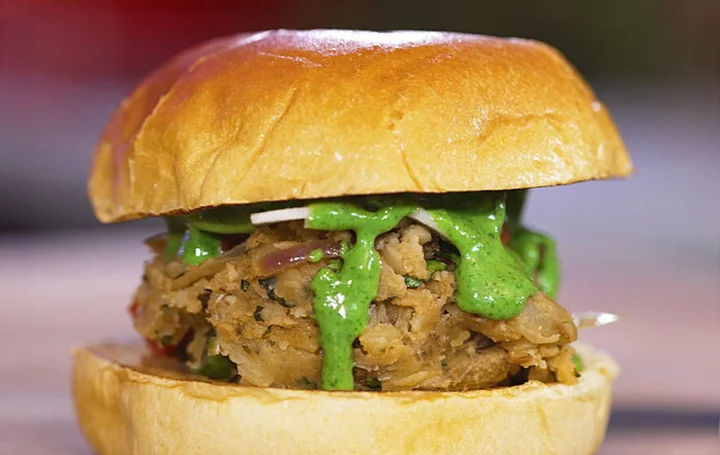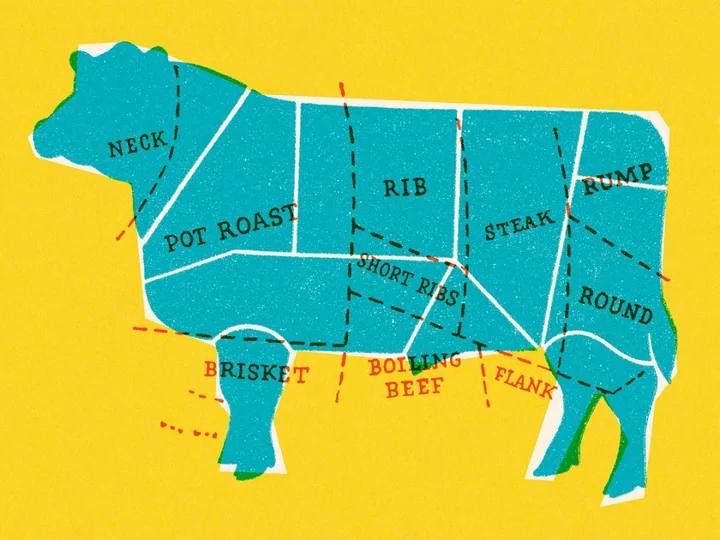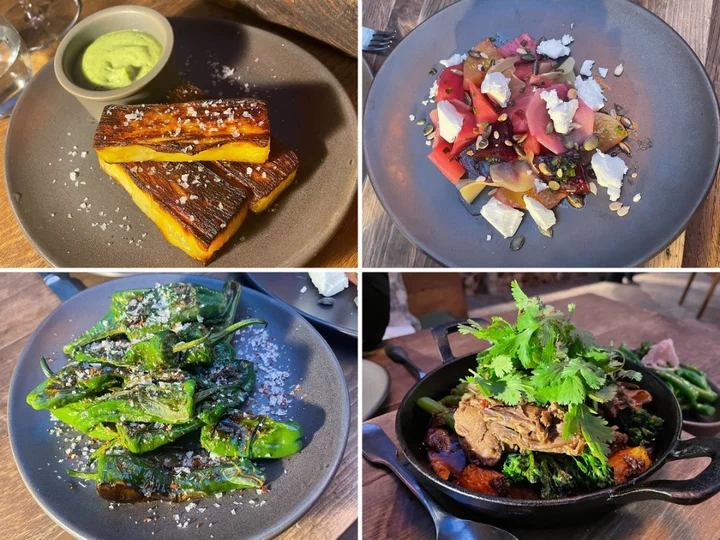
TikTok viewers spark debate over whether or not to wash chicken - so who’s right?
A TikTok creator’s video sparked debate over whether or not chicken should be washed before it’s cooked. Zoe Barrie (@zoebarrie) posted a video, which has now reached over 3.4m views, on 17 July to reveal her step-by-step process for cooking “spatchcocked roast chicken.” Though the footage was one minute and 23 seconds long, skeptical followers were only concerned with the first 30 seconds: the prep work. Barrie was seen unpackaging a full raw chicken, taking out the guts, and cutting it open. She moved the meat to a wired tray and sprinkled it with salt crystals. Barrie proceeded to place the bird in her fridge before blotting it with a paper towel and searing it in a pan. Immediately, critics flooded the woman’s comment section to question her methods. “Wait, no wash?” one TikTok user asked, while another added: “Um, did you wash it first, though?” “Don’t you rinse before cooking?” one person questioned. Among the suspicious users, kind followers came to Barrie’s defense when they didn’t believe that washing chicken wasn’t necessary. “Washing chicken is as stupid as washing your bread,” one individual wrote. “These washing meat comments are sending me. Y’all are so silly,” another woman remarked. Despite the overwhelming number of individuals who argued raw poultry needs to be rinsed, the Food Safety and Inspection Service (FSIS) advises against it. The FSIS warned that washing chicken leads to the spread and cross-contamination of bacteria and “poultry juices” onto other food and surfaces. Water also won’t “destroy” bacteria like Salmonella or Campylobacter, and “only cooking will destroy any bacteria that might be present on fresh chicken.” @zoebarrie spatchcocked roast chicken ftw 😤 (crispy chicken ib cooking school and samin nosrat & lemon chimichurri ib me) #roastchicken #salt ♬ Wes Anderson-esque Cute Acoustic - Kenji Ueda Cross-contamination increases the risk of food poisoning, according to the FSIS. “This can occur if raw poultry or its juices come in contact with cooked food or foods that will be eaten raw, such as salad,” the report read. Per the 2019 Food Safety Consumer Research Project analysis, individuals who washed their chicken in the sink were more likely to contaminate their produce due to the bacteria left on the surface. The Minnesota Department of Health noted that, even if you wash chicken in a “slow stream of water,” risky germs are still able to splash on to fresh food or other dishes. Although most reports advise against soaking or rinsing poultry, some people still prefer to do so. In this case, the Centers for Disease Control and Prevention put together a list of recommendations for how to safely clean the raw food. First, chefs shoud “run the water gently over the chicken to reduce splashing”. Then, immediately clean the sink and area around the sink with hot soapy water and sanitise it thoroughly. After handling raw poultry, people should also wash their hands for 20 seconds. Barrie went on to let the chicken brown in a pan and bake in the oven. Finally, she garnished the meat with a chimichurri-like spread. The Independent has reached out to Barrie for a comment. Read More Child wiping their hands on wedding dress sparks debate in viral TikTok People are surprisingly divided over burrata as debate oozes online Woman claims restaurant ‘hack’ for toddlers solves family dinners out
2023-08-02 00:52

Do you need to watch what you eat when you’re breastfeeding?
Most new mothers try to breastfeed their baby at first, unable to ignore the oft-repeated mantra ‘breast is best’. However, despite the vast benefits of breastfeeding that are being highlighted during World Breastfeeding Week (August 1-7), including protecting the baby from infection and disease, and health benefits for the mother, a huge proportion of mothers quickly give up. Figures from the last UK-wide Infant Feeding Survey (albeit from 2010) found that while more than three-quarters of women start breastfeeding when their baby’s born, this drops to 55% doing any breastfeeding at six weeks, while at six months, just 34% do any breastfeeding, and only 1% breastfeed exclusively. There are many reasons for this, but Public Health England research found more than half of mothers were concerned they might need a special diet to breastfeed, and a similar proportion were worried that breastfeeding meant they couldn’t tell if their baby was getting too much or too little milk. But should new mums really be concerned about eating or not eating specific foods if they’re breastfeeding, and can their diet affect how much milk their baby’s getting? The simple answer is no, as long as they’re eating a healthy balanced diet, says the baby charity Tommy’s. Because while the NHS warns pregnant mothers to avoid specific foods like soft blue cheeses, undercooked meat, liver, pâté and game meats, there are no foods breastfeeding mums must not eat, says Tommy’s. “There are a lot of myths out there around breastfeeding which can leave new parents unsure of what to do and where to turn,” says Tommy’s midwife Sophie King. “If you choose to breastfeed or combination feed, there’s no special foods you need to have, but a varied diet can help our bodies make the best quality milk for our babies. This typically includes lots of vegetables, fruits, grains and proteins. It’s also important that you stay well-hydrated with plenty of water. “ In addition, she says it’s recommended that mothers who are exclusively breastfeeding take a daily vitamin D supplement. An occasional alcoholic drink is unlikely to cause any harm if you’re breastfeeding, says King, but she warns: “Try not to have more than one or two units of alcohol once or twice a week. There’s some evidence that regularly drinking more than two units of alcohol a day while breastfeeding may affect your baby’s development.” In addition, caffeine can reach babies through breast milk, and King explains: “Caffeine is a stimulant, so if you have a lot, it may make your baby restless and keep them awake.” Caffeine occurs naturally in lots of foods and drink, including coffee, tea and chocolate, and it’s also added to some soft drinks and energy drinks, as well as some cold and flu remedies. “There’s not enough information to say how much caffeine is too much, and babies respond to caffeine differently,” says King. “But it’s a good idea to reduce how much caffeine you drink, especially when your baby is less than six months old.” But does what a mother eats affect her milk supply? Again, the answer is no, explains Justine Fieth of the breastfeeding support charity La Leche League GB (LLLGB). “There are no particular foods you need to eat to increase breastmilk – milk production is determined by the amount of milk removed from the breast,” she says. Breastmilk is made in the mother’s breasts, directly from her blood, rather than from the food she eats. Fieth says LLLGB recognises the importance of a varied and healthy diet, and stresses that it’s important for mothers to speak to a qualified breastfeeding supporter if they feel they have low milk supply. “Unless there’s a physical or physiological reason for low milk production, a mother who breastfeeds on cue will be able to produce enough milk for her baby, regardless of what she eats,” she explains. “In certain circumstances, medications can be used to increase supply, but diet plays a minor part – though obviously, eating a varied, healthy diet is always a good thing.” For breastfeeding support, contact the National Breastfeeding Helpline on 0300 100 0212. Read More Charity boss speaks out over ‘traumatic’ encounter with royal aide Ukraine war’s heaviest fight rages in east - follow live Sten dos: What you need to know about the quirky wedding trend Why have the birds disappeared from my garden? Psoriasis Awareness Month: Everything you need to know
2023-08-01 17:26

Subway offers free sandwiches for life contest if you legally change your name
American food chain Subway has launched a “free sandwiches for life” contest for anyone willing to change their name to “Subway.” The sandwich company announced the start of their new customer competition this week with a desirable “Deli Hero” prize. One fortuitous winner who would legally change their name to “Subway” will be picked to get free stacked meat and double-cheese subs for the rest of their life. From 1 August to 4 August, any adult can go online to SubwayNameChange.com to enter and potentially win a lifetime of “Deli Heros”. “Subway is looking to reward its biggest fan with free subs for life if they legally change their first name to Subway,” the announcement on the company’s website read. “Subway brand love and dedication run deep, especially when free sandwiches are up for grabs.” All fees associated with changing the winner’s name will be covered by the company, but the winner must consent to a background check and provide the company with proof they changed their name within four months of being picked. Then, they will receive $50,000 in Subway gift cards. This isn’t the first time Subway has promised one lucky contestant a lifetime of free subs. “In 2022, one superfan camped out for two days to get a footlong tattoo of the Subway Series logo in exchange for free Subway for life,” the chain declared in the announcement. Subway introduced their “Deli Hero” menu item this month when their plans to invest in fresh slices of meat were underway. The food chain spent more than $80m buying and installing new meat slicers in over 20,000 locations. Since then, Subway has reported moer than $2m in sales for the “Deli Hero” pick, according to a CNN Business report. In 1965, Fred DeLuca co-founded the company with the financer Peter Buck. Back when there was only one sub shop in Bridgeport, Connecticut, the name was “Pete’s Super Submarines.” Now, the restaurant has more than 42,000 locations across 100 countries. According to a 2020 Business Insider report, “Subway has the most locations of any fast-food chain on the planet.” In terms of sales, McDonald’s is the number one fast-food chain. Per The Takeout analysis, McDonald’s reported $48.7bn and Subway reported $9.2bn in sales in 2022. Read More Subway launches bizarre Creme Egg sandwich — but they’re only available in four stores The biggest new vegan launches to know for 2023, from Pret to Wagamama Subway sandwich chain co-founder Peter Buck dies at 90
2023-08-01 05:56

London chef apologises after criticism for all-white, all-male kitchen team
A London-based chef has apologised for what his peers branded a “rude” response towards criticism, after he faced backlash online for revealing the line-up of his kitchen team at his Notting Hill restaurant. Thomas Straker, who opened his namesake restaurant Straker’s in 2022, recently shared a photograph of his “chef team” comprising eight people, including himself. All eight members of the team pictured were white and male, prompting complaints from social media users who believed it did not reflect the diversity of London. Some comments claimed Straker’s team showed how the food industry was a “white boy’s club”, while others urged the restaurateur to provide chefs from minority groups a “safe place to grow as chefs”. Straker, who found fame by sharing his recipes and cooking videos on TikTok, responded to the negative backlash by commenting: “Honestly, people need to calm down. Firstly, there is a shortage of chefs/hospitality workers. Secondly, if you feel so passionately, please go and gather CVs of any chefs you think we’re missing in the team. Solutions not problems. Thank you.” However, his response has also been criticised as “rude”, with a number of chefs and other figures in the food industry weighing in on the online storm. He has since shared an apology via his Instagram Story. “On Friday night, I put up a post of my chef team and many rightly pointed out the lack of diversity in it. I am very sorry for my initial response, where some queried whether I take this issue seriously,” he said. “I am absolutely committed to ensuring diversity in my restaurants, unfortunately we aren’t achieving this in my kitchens currently and this is an area I know I need to improve on, making sure it is seen as a welcoming and approachable environment for all. Tom x.” Becky Paskin, a drinks expert who appears regularly on ITV’S Love Your Weekend, wrote on Straker’s original post: “Too often we say, ‘We only recruit on the basis of the best people for the job’ without any consideration the role bias plays in the selection process. “It’s been proven time and again that diverse teams are more creative, productive and successful. If every member looks the same and has the same background, you’ll find they’ll all think the same as well. Forming diverse teams is not only the right thing to do, it makes business sense too.” US chef Kenji Lopez-Alt, who is known for his book The Food Lab: Better Home Cooking Through Science, added: “Get off the social media for a week or so. Do some reflection. Talk to people who care about you and who you trust. Be better.” However, some people have defended Straker’s choice to hire who he wants in his team, and pointed out the staff shortage affecting the entire restaurant industry. Henry Tilley, restaurant manager at Native in London, wrote: “The industry is on its knees right now. There [aren’t] enough chefs or even [front-of-house staff] to go around as it is. We would love some applications for chef positions in our restaurants from female or non-binary individuals. The reality of the matter is we never get the applications so can’t be as representative as we’d like.” But Ben Mulock, executive chef of Balans in Soho, says the onus is on senior chefs to “solve the problem” of lack of diversity, instead of “asking others to solve it for us”. He told The Independent: “I am a white male executive chef, so it is my responsibility to push for an inclusive workforce, be that sex, age or ethnicity. They are not mutually exclusive – they are all important. “No, it’s not easy and at the moment, it almost seems impossible to recruit, but if we don’t try, we don’t move it forward. We always need to do better for this industry, and if we can’t do it in London, where can we?” While Straker’s post was not intended to stir controversy, the lack of diversity in his team has “shone a light on the broader challenges we face in kitchens these days”, Hannah Norris of Nourish PR said. “This is a classic case of an ill thought-out post,” she told The Independent. “Thomas Straker has issued what he believed was a photo of a group of confident, strong-looking chefs ready for service but didn’t think about the optics of the image and what it represented. “Whilst it was well-meaning I believe, a picture doesn’t lie. For whatever reason, he currently has no women or people of colour in his kitchen, so it all looks a bit ‘pale, male and stale’. Perhaps the reaction to this image will make Thomas think again a bit more carefully about who he wants to employ in the future.” The Independent has contacted Straker for comment. Read More The dish that defines me: Frank Yeung’s prawn wontons Between Brexit and Covid, London’s food scene has become a dog’s dinner – can it be saved? Prince William serves up vegetarian ‘Earthshot burgers’ to shocked diners Restaurant introduces ‘minimum spend’ that sees solo diners pay double to eat alone Restaurant with ‘tips are a privilege’ policy sparks intense backlash on social media How to make the Prince of Wales’s Earthshot burger
2023-07-31 21:24

How to make the Prince of Wales’s Earthshot burger
The Prince of Wales has teamed up with popular YouTube channel, Sorted Food, to create the first Earthshot Burger. The veggie burger was created with Earthshot Prize-winning products, and a video posted on YouTube shows William handing out meals from a food van in central London with the Sorted Food chefs. The burger, filled with vegetables, spices, pickles and finished with a minty vegan mayonnaise, was developed by the sustainable packaging start-up Notpla (winner of the Build A Waste-Free World category), environmentally-friendly stove company Mukuru Clean Stoves (winner of the Clean Our Air category), and Kheyti’s Greenhouse-in-a-box, winner of the Protect and Restore Nature category. The collaboration is part of The Earthshot Prize’s new partnership with YouTube, to encourage users to create more content around climate change. Here’s how you can make your own at home… The Earthshot Burger Ingredients: (Serves 4) For the pickle: 1 cucumber, 2mm slices 1 mouli, peeled and cut into 2mm slices 200ml white wine vinegar 75g caster sugar 1tsp chilli flakes 1tbsp coriander seeds ½tbsp fennel seeds 1tsp mild chilli powder 1tbsp ground coriander seed 1tsp garam masala For the burger mix: 6tbsp vegetable oil 2tsp cumin seeds 1tsp mustard seeds, brown 1 red onion, peeled and finely chopped 6 cloves garlic, peeled and minced 40g ginger, finely chopped 2 green chillies, finely sliced 1tsp turmeric 1 red pepper, deseeded and sliced 200g white cabbage, shredded 200g cauliflower, finely chopped 100g green beans, finely sliced 500g white potato, steamed and cooled 30g coriander leaves, chopped For the sauce: 200g vegan mayonnaise 60g coriander 20g mint, leaves only 20g ginger, peeled To serve: 4 burger buns, sliced and toasted Method: For the pickle: 1. Place the sliced cucumber, mouli and one tablespoon salt in a large mixing bowl and mix well. Allow to sit for 30 minutes. 2. Add 400 millilitres water, vinegar, sugar and spices to a medium saucepan and bring to a simmer over a high heat. Once simmering, remove the pan from the stove. 3. After 30 minutes, tip the salted cucumber and mouli into a colander and rinse under cold running water then add them to the warm pickle liquid. Stir well and allow to cool. For the burger mix: 4. Heat the oil in a large saucepan over a medium heat. Add the cumin seeds and mustard seeds and fry for two minutes until fragrant and starting to pop. 5. Add the onion, garlic, ginger and chillies, along with a pinch of salt and continue to fry, stirring occasionally for five to seven minutes until the onion is starting to colour. 6. Tip in the spices and stir to combine. 7. Tip in the sliced pepper and continue to cook for five minutes until the pepper softens and releases its liquid. 8. Add in the cabbage, cauliflower and green beans, stir everything together and cover the pan with a lid. Allow the vegetables to soften for five minutes. 9. Coarsely mash the potatoes in a bowl and then add them, along with the coriander to the pan. Stir everything together and taste and adjust the seasoning. You are looking for a thick mashed potato texture. 10. Remove the pan from the stove. For the sauce: 11. Add the mayonnaise, herbs, ginger and a generous pinch of salt to the jug of a blender and puree until smooth. Taste and adjust the seasoning. To serve: 12. Divide the mashed potato and vegetable filling between the toasted buns. Top each with a couple of pinches of pickled vegetables and finish with the herb sauce. Read More ‘Nicely cooked’: Watch moment Prince of Wales serves burgers to surprised diners in London The dish that defines me: Frank Yeung’s prawn wontons Seann Walsh explains reason behind his ‘strange request’ at restaurants
2023-07-31 20:26

The dish that defines me: Frank Yeung’s prawn wontons
Defining Dishes is an IndyEats column that explores the significance of food at key moments in our lives. From recipes that have been passed down for generations, to flavours that hold a special place in our hearts, food shapes every part of our lives in ways we might not have ever imagined. There is a family scene I would love to engrave into my memory that involves my father, myself and my son, all making prawn wontons in one kitchen. Prawn wontons are so simple, like all good dishes, and they have a really special place in my heart. I have very fond memories of making them with my father, who is from Hong Kong, when I was growing up and it is my favourite dish. Now, it’s my five-year-old son’s favourite dish as well and he’s the same age I was when I first started making prawn wontons with my father, so it makes me excited to share the dish with him. When my son was younger, his Ye Ye (grandfather) would bring homemade wontons whenever he came over to my house in Peckham. But just recently, we were over at my parents’ home, and he made his first wonton. We were all very proud! It’s so nice because it’s a dish that has run right through my family, it was brought and championed here by my dad. He moved here in 1975 and has the classic first-generation immigrant story. He worked three jobs, moved around a lot, saved money and opened his first restaurant in 1985, 10 years after arriving in England. He finally retired in 2017, but he couldn’t get away from my restaurants. I opened my own establishment, Mr Bao in Peckham in 2016, and then Daddy Bao in my father’s honour. Even now when he comes around to visit, I make him talk more about restaurants. I think he enjoys it, though, and it reminds him of home. That’s really important now because ever since the 2019-2020 mass protests in Hong Kong, the country is a sad place at the moment if you’re from there. But it’s still an amazing place. My favourite part about making wontons from scratch was always the time spent with my dad. The chit chat between us, me kneeling on a stool and him standing at the counter. My hands were not as dextrous at that age and I certainly wasn’t practised, but he would be there to help show the right way to make the little parcels and finish them up for me. The bonding moment is what I cherish the most. Mum is English and she got involved too, she is actually amazing at it. Prawn wontons are also part of Christmas time for my family. Our big tradition is to have a massive steamboat on Boxing Day, which most people of Chinese descent will be familiar with. It usually involves a big, steaming pot of soup on a constant boil, and everyone sits around the table cooking fresh, raw ingredients in it and eating as they go. Prawn wontons are a big, big part of that meal for us, especially now that we have a couple of young kids running around at Christmas time, they really love it. The thing I remember most about making wontons with Dad is the filling. He has his own method for making the prawn mince that goes inside the parcels. He gets his prawns and chops them up, mixes them with any additional ingredients like garlic, and then he would make me pick up a handful of the mixture and throw it back down onto the chopping board, pick it up and throw it back down. It somehow aerates the mince and softens it, and makes it stickier so there aren’t big chunks of prawns floating around. I haven’t really adapted Dad’s recipe for myself, aside from the type of dipping sauce I like to have with them. We keep it very traditional. Oh, I suppose I do have a slight modification, actually. I like to mix gambas (white) prawns from the southwest coast of Spain with North Atlantic shrimps, which are tiny, tiny little crustaceans the size of your nail. They have got a really good flavour. I like to chop those up into the mince with the bigger prawns, add a bit of salt and white pepper, stir it through and then do the throwing method as my dad does. We usually make our own wonton skins. In a pinch, we’ll use shop-bought ones, but when we know we’ve got time we’ll make our own. At the moment, Dad makes handmade dumplings with my sister for her business so they have a dumpling skins machine – but we used to make them by hand, old-school style. He would roll them out because he could get the thickness of the skins right. It wasn’t possible when I was young as I had no idea and was clumsy! They have to be thin, but not so thin that they break or the wontons will open up in the water. It’s something I haven’t managed to master, but there’s still time. Some places don’t even use the regular wonton skins, and they are still amazing. One of my favourite restaurants ever was in Hong Kong – it has closed down now – but it was a hole-in-the-wall type of place that served two types of wontons: classic wontons or fish skin wontons. That was their entire menu. They used fish skins instead of pastry skins to wrap their wontons, and they were something like £1.20 for a bowl at the time. It was definitely the best meal I had with Mum, Dad and my sisters in Hong Kong. The wontons get boiled for two minutes. You can make a wonton soup with a base stock, using ginger, spring onions, salt, pork bones. Boil that down and skim off the top. Or, you can dip the wontons into a chili garlic sauce, which is how my dad likes – although another way I differ from Dad is that I like to add black vinegar to the sauce of soy sauce, garlic and chili, to add an extra layer of acid. You can also eat them as they are, they are completely delicious. My stomach is rumbling as I think about them. As my son gets older, it will be really nice to be able to make wontons altogether, the three generations of us at the kitchen island, chatting away. That’s what I’d like my son to take away from those sessions, the memory of doing it with his Ye Ye and me. I’d also like him to, in time, be able to link quality to food and what you’re putting in your body. I want him to understand that even though it’s so easy to go to the shop and buy something, everything starts out as a living thing. A prawn is an animal and a chive is a real plant grown in the soil. You don’t have to make it yourself and you should go to restaurants to support them, but when you do go, you’ll have a better appreciation for it. Frank Yeung is the chef-owner of Mr Bao and Daddy Bao in London. Read More The dish that defines me: Alex Outhwaite’s Vietnamese bun cha The dish that defines me: Eddie Huang’s Taiwanese beef noodle soup In Horto: Hearty, outdoorsy fare in a secret London Bridge garden Five dinner ideas from around the world to try this week Hi Barbie! Nine cocktails inspired by the doll’s most iconic outfits
2023-07-31 17:20

Experts reveal why you keep waking up at 4am, and how you can prevent it
Ever find yourself awake, staring into space at four in the morning? Is it just a bad habit, or is there something more sinister going on? And why does it always seem to happen at 4am? “We start to experience less deep sleep after around four to five hours,” says Lisa Artis, deputy CEO of The Sleep Charity, who have partnered with Simba mattresses. And once we’re in that lighter sleep faze, we wake much more easily. If you generally fall asleep around 11pm – which is a very common bedtime, 4am wake-ups are more likely. And there are many factors leading to these inconvenient stirrings. Hormones “Sleep is guided by our internal clock or circadian rhythm. One of the most significant and well-known circadian rhythms is the sleep-wake cycle,” Artis continues. “Sleep is regulated by the levels of two hormones: melatonin and cortisol, which follow a regular 24-hour pattern. Melatonin assists you in dozing off, while cortisol helps get you up, and keeps you awake,” she explains. Keeping an eye on your hormones is important in preventing those late-night wake-ups. “Engage in calming activities before bedtime, such as reading, listening to soothing music, or practising relaxation techniques, like deep breathing or meditation,” says Dr Mariyam H. Malik, GP at Pall Mall Medical. Equally, pop your phone down for a bit. “Blue light from electronic devices can suppress melatonin production. Try to avoid screens for at least two hours before bedtime, or use blue light filters. It is best to charge them in a separate room overnight,” Malik adds. Diet Caffeine, heavy meals, alcohol, sugar, and a lack of magnesium or B vitamins could lead you to have a more disturbed night’s sleep, according to Malik. Sugar and carbohydrates may have a particular impact. “A diet high in sugar and refined carbohydrates can cause blood sugar fluctuations, leading to wakefulness during the night,” she says. “It’s unlikely you’ll feel hungry in the middle of the night if your blood sugar dips,” notes Artis, “but to reduce ungodly hour awakenings, trial alternatives for your last meal or snack of the evening. Instead of carb or sweet-based snacks, opt for protein-packed and magnesium-rich foods, like hard boiled eggs, cottage cheese, pumpkin seeds, spinach, dark chocolate, cashews, chicken thighs or turkey.” Protein can take the edge off your night-time hunger, she says, while magnesium is known to support sleep. Needing a wee Do you wake up needing to wee at the same time every night? “Try not to drink excessive amounts of fluids before bedtime,” advises Malik. “It’s important to stay hydrated, but try not to drink anything for around two hours before your usual bedtime. Go to the toilet before you go to bed to empty your bladder. ” Age and life stage “Sleep tends to become more disrupted as people get older,” Malik explains. “Sleep patterns change with age, and various factors can contribute to sleep disturbances in older adults. Some common reasons for sleep disruption in the elderly include changes in your circadian rhythm, decreased melatonin production, medical conditions or medications, and potential sleep disorders.” It can also affect women during the perimenopause. “The reproductive hormones – oestrogen and progesterone – are entwined with the sleep and relaxation hormones, melatonin and serotonin,” says Artis. “When oestrogen begins to fall before and during menopause, it can create a disturbance in the sleep-promoting hormone melatonin, meaning it can’t properly balance out cortisol. When this happens, the ability to fall and stay asleep is affected.” Recurring hot flushes, night sweats, dry skin, and low libido can signal waning oestrogen. Artis advises incorporating foods with high levels of phytoestrogens into your diet throughout the day to help with this. “Phytoestrogens imitate the natural estrogens found in your body. As a consequence, they can bind to your body’s oestrogen receptors and produce similar effects.” Try lentils, kidney beans, chickpeas, tofu, edamame, spinach, cauliflower and broccoli. Worrying Stress is not good for sleep. One study by Bupa even found that 32 million Brits wake up worrying about their health at precisely 4:05 am. The report, which surveyed 4,000 British adults, revealed that more than three-fifths of us wake up in the middle of the night. If you are finding yourself awake at all hours worrying, or waking up with stressful dreams, there are a few things that may help. “Keep a journal by your bedside and write down your worries before going to bed. This practice can help get your concerns out of your mind and onto paper, making it easier to let go of them temporarily,” says Malik. You may also want to “engage in mindfulness or meditation exercises before bedtime. Mindfulness can help you focus on the present moment, reducing anxiety about the past or the future.” Read More Men have a problem – and it won’t be solved by either Andrew Tate or Caitlin Moran Elon Musk reacts to ex-wife Talulah Riley’s engagement to Thomas Brodie-Sangster Thomas Brodie-Sangster references Love Actually in sweet engagement announcement with Talulah Riley Charity boss speaks out over ‘traumatic’ encounter with royal aide Ukraine war’s heaviest fight rages in east - follow live
2023-07-31 17:19

Blood, guts and cheap cuts: We need an alternative to eating animals – and ‘ethical meat’ isn’t the answer
Amber Husain was cooking dinner for a friend when she suddenly realised the meat she was preparing was a corpse. She looked at the chicken in front of her and was overcome with a visceral sense of disgust. Instead of food, she saw “a carcass – plucked, beheaded, and fleshy”. Husain was 26 when she had this epiphany, and it served as a wake-up call not just for her stomach but her mind, too – as her personal tastes shifted away from meat products, her political outlook on the meat industry and food production more broadly also altered and expanded. Five years later, that moment of revulsion forms the opening of her new book, Meat Love, in which she scrutinises the idea of “ethical” meat consumption, and dares to ask how the contemporary middle classes have come to criticise “the worst violence against animals” while still happily feeding on their flesh. Why, for example, has well-heeled, middle-class London gone nuts for slurping bone marrow from the shin bones of baby cows? Why is offal on so many trendy menus? How has contemporary culture at large come to accept that factory farms are monstrous, but that if animals are cared for, cherished and loved while alive, we should feel better about killing them for our carnivorous pleasures? “For ages, I was one of those carnivores who felt mildly bad about eating meat but just turned that into this inane, self-consciously sadistic part of the pleasure of it all,” Husein tells me. “The more my diet started to revolve around stuff that wasn’t meat, the weirder meat started to feel. Interestingly, once my stomach had been radicalised, I found I had a much greater intellectual openness to thinking about the politics of meat.” Having freed herself from the conflict of eating meat but also feeling bad about it, she found she was able to go beyond those questions of morality – which she suggests can be “stifling” – and think politically. “Now that I have no desire to eat animals, there’s nothing to stop me reckoning with what it means that the meat industry [consists of] an underclass of both humans and animals who are exploited and – in the animals’ case – killed for pleasure and profit.” This is the essential crux of Husain’s argument, and it’s something often lacking in discussions around the “ethics” of meat consumption. For Husain, the question is not, “how can humans eat meat responsibly?” but “how are certain lives devalued to an extent that their suffering can be written off, in order to ‘make a killing’?” What she’s saying, in other words, is that whether the meat on the table has come from a factory farm or an organic farm, or whether you’re tucking in at Burger King or the River Cafe, the path to the plate is still paved with violence. And, while current cultural trends may claim it is better to love and respect an animal before killing and consuming it, perhaps what this cultivates is the ability to embrace exploitation “in a spirit of virtuous indulgence”. What does it really mean, for all living beings, if love is imagined as compatible with killing? “To slide your buttery hand between the flesh and skin of a thing that, if only for a moment, you have re-learnt to perceive as a corpse, is to give an invigorating massage to your sense of political possibility,” Husain writes in Meat Love. By the slim book’s end, her invigorated “sense of political possibility” has led to “a ravenous hunger – a desire for a different culture, a different society”; a new world “in which no one, neither animal, immigrant, worker, woman, or peasant, was considered a thing to be owned, controlled, killed, or left to die”. For many, the leap from a chicken breast on a plate to the exploitation of oppressed people around the globe might seem like a vast one. Yet, it certainly seems clear that there has been a marked shift in the way meat is conceived and consumed – among the middle classes, at least. Since the turn of the millennium, foodie figures like Hugh Fearnley-Whittingstall have been promoting “seasonal, ethically produced food” as part of a broader commitment to caring for the environment. At the same time, a distinctly carnivorous spirit has taken hold – one that professes to be an “honest”, “grounded” and “down to earth” ethos. “Good food, good eating, is all about blood and organs, cruelty and decay,” Anthony Bourdain wrote at the start of the 1999 New Yorker article that would, eventually, catapult him into global foodie fame. I find it easy to laugh at Hugh Fearnley-Whittingstall and people like that, but I’m not totally convinced that they’re really the bad guys Lewis Bassett Then there’s Fergus Henderson and St John – the illustrious London restaurant, born in 1994 on the premises of a former bacon smokehouse, which popularised “nose to tail” dining. This offal-centric “no waste” approach is neatly summed up in Henderson’s oft-quoted phrase: “If you’re going to kill the animal, it seems only polite to use the whole thing.” Traditionally “cheap cuts” are “elevated” from a source of sustenance for the working classes, to a source of virtue for the urban bourgeois. According to its own cookbook, St John dishes combine “high sophistication with peasant roughness” – that winning aesthetic formula that also sees middle-class urbanites flocking to farmers’ markets and chugging natural wine. In a sharp and searing piece for food and culture newsletter Vittles, writer Sheena Patel dubs this “Rich Person Peasantcore”, asking: “Why are these influencers pretending that they themselves till the land and eat like 17th-century French peasants when in fact their chopping boards cost more than most people’s rent?” In the face of swathes of small plates adorned with offal, and slices of ham served for upwards of £20, it seems like a pertinent question not just for influencers, but also for today’s trendiest restaurateurs and diners. Lewis Bassett is a chef and the host of The Full English podcast, which, over its two seasons, has dived into everything from the birth of “modern European” cuisine to high food prices, factory farms, and why Britain is in love with Greggs. “It’s interesting the way we create these fantastical worlds for us to eat within,” he says. “It is clearly a fantasy to imagine that you can have the rural experience of a peasant in France or Italy, in modern-day Britain.” Yet, he also says that this trend is far from new. The current “rustic” style – typified by “nose to tail eating” – is, he suggests, “intimately tied with what you could call a culinary and broader cultural movement that appears in the wake of countercultural movements in the Sixties, and eventually finds its way into food, especially as some of those countercultural people get a bit older and a bit more affluence”. Essentially, “it’s the same thing that manifested in places like Habitat,” he says, of the homewares and furnishings brand founded in 1964 by Terence Conran. Both design and dining were transformed, offering experiences to the middle classes that were both refined and casual at the same time. Alongside that cultural shift, and “that fashion for pared-down forms of eating out”, Bassett notes the arrival of a broader awareness of environmental and animal welfare concerns. “It’s obviously easy to ridicule these middle-class forms of culture,” he says, “but these concerns are ones I certainly share and I think should be considerations for everyone. I find it easy to laugh at Hugh Fearnley-Whittingstall and people like that, but I’m not totally convinced that they’re really the bad guys.” So is there a danger that legitimate backlash to the “thrifty rural”, “nose to tail” trend – and bourgeois “peasantcore” more broadly – could spill over into an attack on all food industry attempts at sustainability? “I think people don’t want stuffy fine dining experiences,” Bassett says, “but at the same time, having the kind of pared-down, rustic, ‘peasant food’ – like, having ham served to you at St John costs you 20 quid – maybe people are slightly sick of that.” He quickly adds, though, that he is “not saying it can come any cheaper than 20 quid, because when you spend a lot of time and effort rearing animals properly, and paying chefs properly, and paying rents in your restaurants, that racks up”. It seems there is a tension, then, between practical and immediate ethical matters – such as paying food industry staff liveable wages or reducing food waste – and broader questions about what kind of society we wish to live in or create. Is the question of “ethical” meat consumption, as Husain suggested, “beyond morality” – a question of politics only? Or is it still, at heart, a moral dilemma, based on people’s personal sense of “right” and “wrong”? Summing up Husain’s attitude towards animals in Meat Love, Bassett suggests “she’s saying that, if you love them so much, why are you killing them? I suppose where Amber Husain and I would slightly disagree is that I’m not convinced that killing an animal is inherently wrong.” Away from the carnal appreciation and “peasantcore” of contemporary restaurant culture, meat-eating often seems to be conceived as either a “guilty pleasure” or a “grim necessity”. In all these cases, however, there appears to be an overriding sense that there is “no alternative” to a meat-eating status quo. The late cultural critic Mark Fisher famously used similar terms to define “capitalist realism”, meaning that capitalism is the only viable economic system, and thus there can be no imaginable alternative. Is it possible we’re also stuck in a kind of “carnivorous realism”? If so, it might be because the two are so interlinked. As Husain puts it, “meat is the inevitable outcome of an economic system that relies on cheap labour and cheap life. But that doesn’t mean meat is a necessity, it means a new economic order is a necessity.” Perhaps taking the leap from a vegetarian diet to full-scale social and economic revolution still seems unthinkable to many. But, in nasty, brutish and austere times, it has also perhaps never been more necessary to seriously consider who can eat, and who is made meat. “I think we need an avalanche of political will from within the food justice, land justice, climate justice and labour movements to radically transform society,” Husain says. With that as the goal, she believes it isn’t helpful “for us to be clinging to the idea of meat as a pleasure”: “If we can’t imagine something other than animal flesh to eat for dinner we might struggle to imagine an entirely different society.” ‘Meat Love: An Ideology of the Flesh’ by Amber Husain is out now Read More Between Brexit and Covid, London’s food scene has become a dog’s dinner – can it be saved? It’s time for booze bottles to have health warning labels Should I give up Diet Coke? With aspartame under suspicion, an addict speaks Food portion sizes on packaging are ‘unrealistic and confusing’, says Which? In Horto: Hearty, outdoorsy fare in a secret London Bridge garden Zero-fuss cooking: BBQ pork ribs and zingy Asian slaw
2023-07-30 13:58

Food portion sizes on packaging are ‘unrealistic and confusing’, says Which?
Portion information on food packaging is too “confusing, inconsistent or unrealistic” for people to get a clear understanding of how much sugar, fat and salt they are consuming, according to new research. Which? surveyed more than 1,200 people on portion sizes and found that a large number of people could not estimate correctly how many servings popular supermarket foods contained. The consumer champion found that respondents often assumed portions were larger than the suggested serving sizes listed on the packaging, and labelled the latter “small” and “unrealistic”. For example, more than half of respondents thought a 225g pack of halloumi would cover two to four servings, but the package information suggests it should feed seven. More than a third of respondents thought a tub of Pringles contained two to four portions, but the packaging suggests it contains six to seven servings of around 13 crisps per person. The majority (79 per cent) of those who took part in the survey thought a supermarket meal deal was designed to serve one person, given they are typically purchased for a single person’s meal. However, Which? pointed out that while the sandwich is usually for one person, the drink and snack that are usually included in the deal may be designed for two. The research also found inconsistencies in portion sizes across pack sizes for popular products. Walkers Ready Salted Crisps come in three different individual pack sizes ranging from 25g per pack in a multipack to 45g in a grab bag, but these all count as one portion. Meanwhile, a 150g sharing bag suggests that a single portion is 30g. Other products that have similar inconsistencies include Cadbury’s Dairy Milk, which have recommended serving sizes ranging from 20g to 33.5g. Which? also found inconsistencies in serving size suggestions depending on the brand, even if the amount of product in a package is similar. A 300g back of Dell Ugo tomato and mozzarella tortellini states that it serves two people, but a near-identical version by Marks & Spencer that also weighs 300g says it contains three servings. Respondents also found it difficult to estimate an appropriate portion size for drinks, it was revealed, after 229 people were asked to pour themselves a glass of wine, juice or smoothie and measure how much they served themselves. Just under half (49 per cent) of white wine drinkers poured themselves more than the recommended 125ml, with the largest pour recorded rising to more than double that (275ml). Among red wine drinkers, almost two thirds (69 per cent) poured a much larger portion, which the largest pour reaching 250ml. More than half (54 per cent) of those who drank orange juice served themselves more than the recommended 150ml, with the largest pour measuring in at 400ml. Orange juice packages show the amount of calories and sugar in a 150ml serving, which is around 62 calories and 13g of sugar. However, a 400ml glass has 166 calories and 35g of sugar, more free sugar than an adult should have in a day according to the NHS. Which? said: “Although traffic light labelling is a useful guide to the nutritional value, for it to be effective it must be based on realistic portion sizes. Manufacturers and supermarkets should look to make improvements and provide clearer labelling on serving sizes so shoppers are not misled about the food they buy.” Customers are also advised to check packaging and to measure portion sizes at home to get a clearer idea of what they should consume looks like according to the packaging suggestions. Shefalee Loth, a nutritionist at Which?, said: “Which? found people can be confused by inconsistent and unrealistic serving sizes and that the way that manufacturers provide these can sometimes make it difficult to assess just how healthy a product is. “Nutrition labelling is really valuable for consumers, including front of pack traffic light labelling, but it needs to be based on meaningful and consistent portion sizes.” Read More Men have a problem – and it won’t be solved by either Andrew Tate or Caitlin Moran Elon Musk reacts to ex-wife Talulah Riley’s engagement to Thomas Brodie-Sangster Thomas Brodie-Sangster references Love Actually in sweet engagement announcement with Talulah Riley In Horto: Hearty, outdoorsy fare in a secret London Bridge garden Zero-fuss cooking: BBQ pork ribs and zingy Asian slaw Brad Pitt and Angelina Jolie ‘set to try and resolve’ longrunning vineyard dispute
2023-07-28 22:46

In Horto: Hearty, outdoorsy fare in a secret London Bridge garden
Walking into In Horto feels like walking into someone’s garden after the green thumbed designers of Your Garden Made Perfect have had their way with it. Stylish yet homely, with thought put into making every corner feel like you’re stepping into someone’s al fresco dinner party – hexagonal red brick flooring, rattan lamp shades and roof, wooden dining tables and chairs, as well as rustic dishes and serving plates. Potted plants welcome you at the entrance and vines twirl around the edges of the restaurant, which gives it an even more cloistered feeling. Just a five minute walk from London Bridge, right next to Flat Iron Square, In Horto has a distinctly different vibe to its packed surroundings. There’s the Borough Market crowd, where inching behind tourists is only made worth it if you procure a sausage roll from the Ginger Pig (mmm, dreamy); while Flat Iron Square boasts a hipper, boozier clientele. In Horto offers a bit of an oasis from both – a quieter, calmer place to sit down and have a meal. In Horto is a venture by TVG Hospitality, also known as The Venue Group, which boasts Mumford and Sons member Ben Lovett as one of its backers. The group also operates Flat Iron Square, which it moved from its original location on the corner of Southwark Bridge Road and Union Street to its current home last year. So it makes sense that the company is trying to develop the area by providing more restaurants with different concepts – it also opened Carrubo next to In Horto, a Mediterranean-inspired “light bites” place. The clue to why the restaurant feels so much like a garden party is in the name; In Horto in Latin is “in the garden”. The cooking on display here is very much focused on outdoorsy, wood-fired cooking, with a beautiful large domed oven taking pride of place behind the counter. Almost every dish is baked, roasted or grilled in this hard-working piece of equipment, bar things like the charcuterie board or the burrata and caponata, but even that has a touch of fire with the addition of smoked white balsamic dressing. In Horto’s menu moves with the seasons, but some things that are a staple and absolutely worth having again and again. The confit potato chips, which have been described as an “uncanny” dupe of Quality Chop House’s own version, are very, very good – layers of nearly paper thin potatoes layered and cooked in a thick wedge, before being portioned into chunky batons and roasted so that they caramelise and crisp up on the outside, but retain a delicious softness on the inside. The heritage beetroot with vegan feta and sunflower and pumpkin seeds also went down a treat, with the earthy, gorgeously red and purple root vegetables allowed to shine. We were big fans of the ’nduja butter and burnt onion butter that can be ordered and slathered with relish on bread. Also enjoyed were tenderly shredded venison batons ensconced in crispy crumbs, and while I generally find padron peppers to be a bit… well, boring, In Horto’s were covered in a healthy sprinkling of Aleppo salt that gave the soft, slightly charred vegetables that much-needed crunch. The mains were hearty and great for sharing, although perhaps less exciting than the starters and sides. There’s only so many roasted vegetables you can eat before it starts to taste a little monotonous. Having said that, the slow roasted braised lamb was a triumph; tender and juicy, with a delicious amount of fat that melts on the tongue. The real joy of In Horto’s menu is that it is all made to be shared, which I love. There is something so comforting and communal about passing dishes to one another, making sure everyone tries a little bit of everything. After all that food, it’d make sense that there was little room for dessert. Except I’m nothing if not determined. We had to be sensible though – the tarte tatin with vanilla ice cream sounded bloody lovely, but would have been far too much and we would have had to be rolled home. Being the balanced and rational eaters we are, we opted to share the rich, luxurious chocolate mousse with honeycomb and salted caramel ice cream. Unwise? Perhaps, just a little. But I have no regrets. In Horto, 53b Southwark St, London, SE1 1RU | inhorto.co.uk | 020 3179 2909 Read More The Union Rye, review: Finally, a decent restaurant in this charming East Sussex town Forest Side: Heavenly Cumbrian produce elevated to Michelin-starred proportions I tried the food at Idris Elba’s restaurant – he should stick to wine
2023-07-28 21:15

Algeria media guide
An overview of the media in Algeria, as well as links to broadcasters and newspapers.
2023-07-28 19:17

Experts reveal the most unhygienic things in your kitchen – and how to get them clean
It’s likely there are countless things in your kitchen which look clean, but actually, they’re filthy. Could your dishcloths be making you sick? When was the last time you washed your tea towels? And do we really need to bleach the sink more than once a month? We asked an expert to find out. Knobs, door handles, and buttons The buttons and dials on your kitchen appliances could be a germ-fest. “People often neglect to clean these areas of the kitchen,” says Danielle Mason, a cleaning content creator – or ‘cleanfluencer’ – who creates tutorials and videos on TikTok and Instagram. “Most of the time, they don’t think it is important, but as you’re commonly handling raw meat and food, it’s extremely important to keep these areas clean, due to cross-contamination. “Always sanitise with a cloth – I like to do this with Zoflora, as it leaves a great smell afterwards, and kills bacteria from dirty fingers.” Cloths If what you clean with isn’t clean, chances are, your kitchen isn’t either. “I always leave my cloth to soak in bleach before going to bed every night,” says Mason. “This enables a new start in the morning with no bacteria. Also, make sure you’re replacing the cloths – I would suggest a new one every two weeks, whilst still bleaching every night. And make sure you’re not using this cloth on anything other than the kitchen, as you do not want to cross-contaminate.” Sponges Mason stresses sponges are unhygienic, as they’re constantly damp and can carry E. coli. “People tend not to use sponges, as they carry so many more germs, and even putting them in the microwave will not kill all of them. Avoid a sponge where possible.” Dish towels Dish towels and tea towels may not be changed anywhere near often enough. “You should have one for every day of the week, as they carry so many bacteria and germs, which get spread across the kitchen. If you’re drying pots and pans, and then wiping down your surfaces, it’s not good,” she says. Chopping boards Chopping boards – particularly wooden ones – could be a haven for bacteria. “You should have a different colour for different types of food, one for meat, fruit, and other foods,” advises Mason. “The best way to clean them is in a dishwasher, as it’s good to get rid of all the germs due to the very high heat. If you don’t like the dishwasher, then boil the kettle water and leave the chopping boards to soak in it. I use a steam cleaner on mine, as it kills 99.9% bacteria and there are no chemicals.” It is best to avoid wooden chopping boards altogether, as these cleaning methods may damage them. Kitchen sink “This is a massive breeder of bacteria and grime; a distinct microbiome is found in sinks. “The plumbing area found beneath sinks revealed microbial communities dominated by a group of bacteria called Proteobacteria. This phylum includes pathogens such as Salmonella and E. coli, which can cause serious disease,” Mason shares. “I’ve always been taught never to wash my hands in the sink, and to never throw dirty water down the sink. You wash your cups and plates in the sink and prepare food, so it should always be kept clean, and nothing from outside the kitchen should cross-contaminate that. For example, never wash your floors and put dirty water in your kitchen sink, always throw it down the toilet.” How do you possibly clean the inside of your sink and drains? “Baking soda and vinegar is the best way to clean your sink out, or bleach, but you must be careful with bleach, as it can stay in the bottom of your sink, depending on the material it’s made of. I clean my sink out every day.” Pipes and cupboards around your sink could be leading you to have a rodent problem. “You can prevent mice and rodents from entering the kitchen by covering any small crevices or cracks. It is also important to repair leaks as soon as they happen, as they can come through the pipes,” she says. Fridges “Deep clean [your fridge] every two months. A normal cleaning – the wiping of shelves – should be done every other day with soapy water. For any bad smells, use baking soda, which will absorb the smell from the fridge,” Mason continues. “The fridge is a breeding ground for salmonella, E. Coli and other bacteria.” Bins Where you throw your waste away could be a breeding ground for germs. “Make sure you keep [outdoor] rubbish bins away from your house, and make sure you empty your bin as soon as it’s full,” advises Mason. “I personally do not keep a bin in the kitchen, I use a bag and I take that out by the end of the day, but if you are using a bin, make sure you bleach it with hot kettle water, to keep it smelling fresh.” Read More This is why you keep waking up at 4am – and what you can do about it TV chef James Martin reveals cancer diagnosis in apology over ‘bullying’ allegations Bursts of activity that make you huff and puff ‘linked to reduced cancer risk’ Charity boss speaks out over ‘traumatic’ encounter with royal aide Ukraine war’s heaviest fight rages in east - follow live
2023-07-28 17:48
